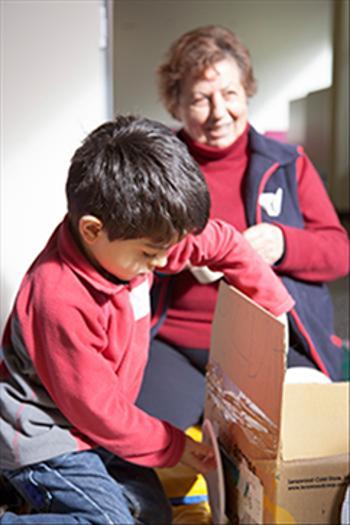Building a car
Duration/age

A cardboard box car can be as simple or as fancy as you like. You’ll need a cardboard box that is big enough for your child to get inside.
Which box can you fit in? Is it too big, too small or just right?
Seal up the box with masking tape. If you want to paint the box now is a good time to do it. Make sure you let it dry before you add the other parts of the car.
What colour would you like your car to be? Can you cover every bit of the box?
Now you have a couple of choices. This could be a car that stays in one place or one that your child can drive around - a mobile car.
If it stays in one place you can talk with your child about what features a car needs and how to make them. You could use paper plates for the wheels and steering wheel. You could also use jar lids or yoghurt container lids for the headlights and indicators.
How can we make a door? Do you need a seat in your car? What about a number plate?
You will need to cut a hole in the top of your car so your child can see where they are going.
For a mobile car, cut a hole in the top and the bottom of the box, so your child’s legs can stick out. Use ribbons or webbing to make shoulder straps.
How long should we make the straps? We don’t want the car to drag on the ground.
Materials you will need
- Paint
- Glue
- Scissors
- Brushes
- A cardboard box
- Paper plates
- Lids
- Tape
- Ribbons
- Paper cups
Alternative tools
- Foam brushes
Skills this activity improves
Why does this matter?
When children are making their car they are using big muscles and small muscles. All this helps them to develop coordination and control, as well as strength.
Planning the steps for building a car helps children to learn about sequencing.
Children will be learning about measurement as they discover the right size box or straps.
They will learn about position as you work out where car features go - the head lights go at the front, the door goes at the side.
Children will also be problem-solving as they work out how to make doors or a seat.
Talking with your child helps to build their vocabulary, in this case about car parts, shapes and numbers.
What does this lead to?
Muscle control helps children when they are learning to write and draw. Being able to hold your body steady and being able to use small muscles means that writing is easier to do.
Learning about sequencing helps children become planners and logical thinkers.
A broad vocabulary helps children express themselves, understand others and will help when they are learning to read.
Problem-solving helps children to think of alternate strategies or methods - a useful learning skill. Being able to recognise shapes, numbers and letters helps children to think mathematically.
Language to use
- Cardboard box
- Car
- Wheels, hub caps, doors, windows, bumper bar, grille, boot, bonnet, roof
- Headlights, tail-lights, indicators
- Front, back, side
- Vroom, brmm, beep, beep
Questions to use
- Should we make a car that you can drive around or a car that you can sit in?
- What does a car need?
- How many wheels will we need? How many steering wheels?
- Where do the headlights go - on the front or on the back?
- Where will you drive to?
Useful tips
- You might also like to take a look at the activities We're off and racing and Working at the car wash.
- For safety information visit www.parenting.sa.gov.au
- Remember to talk to your child in your home language.
More ideas
- Work together to think of different ways to decorate your child’s car- it doesn’t have to look like an ordinary car. It could have your child’s name on it, or a racing car number. It could be a clown car or a fairy car. Will racing stripes make it go faster?
- Maybe you could use differently sized boxes and make a bus, a tractor or a train.
Variation by age
Birth to two year olds
- Babies love to explore cardboard boxes. They are great to climb into and on, sit in and even hide under.
- You can make a baby tunnel by hanging socks or scarves inside a cardboard box. Encourage your baby or toddler to crawl through.
- Drawing inside a cardboard box is a different experience for children. All you need is a box big enough for your child to sit in and some crayons. They can draw all over the inside of the box.
Three to five year olds
- You could make a drive-in movie. Drive your car your car to the front of the TV and watch a movie. You might need to explain just what a drive-in is.
- Use smaller boxes to make cars for your child’s toys. Finding boxes that are the right size for toys that are all sorts of different shapes and sizes toys is great sorting practice.
Language to use
- Through, in, under, over, on
Questions to ask
- How will we get to the drive-in?
- Which movie will we see?
- Which box would Teddy fit in?
- Where could your toys go in this train?
Language to use
- Theatre, movie, film,
- Fit, too big, too small, just right


